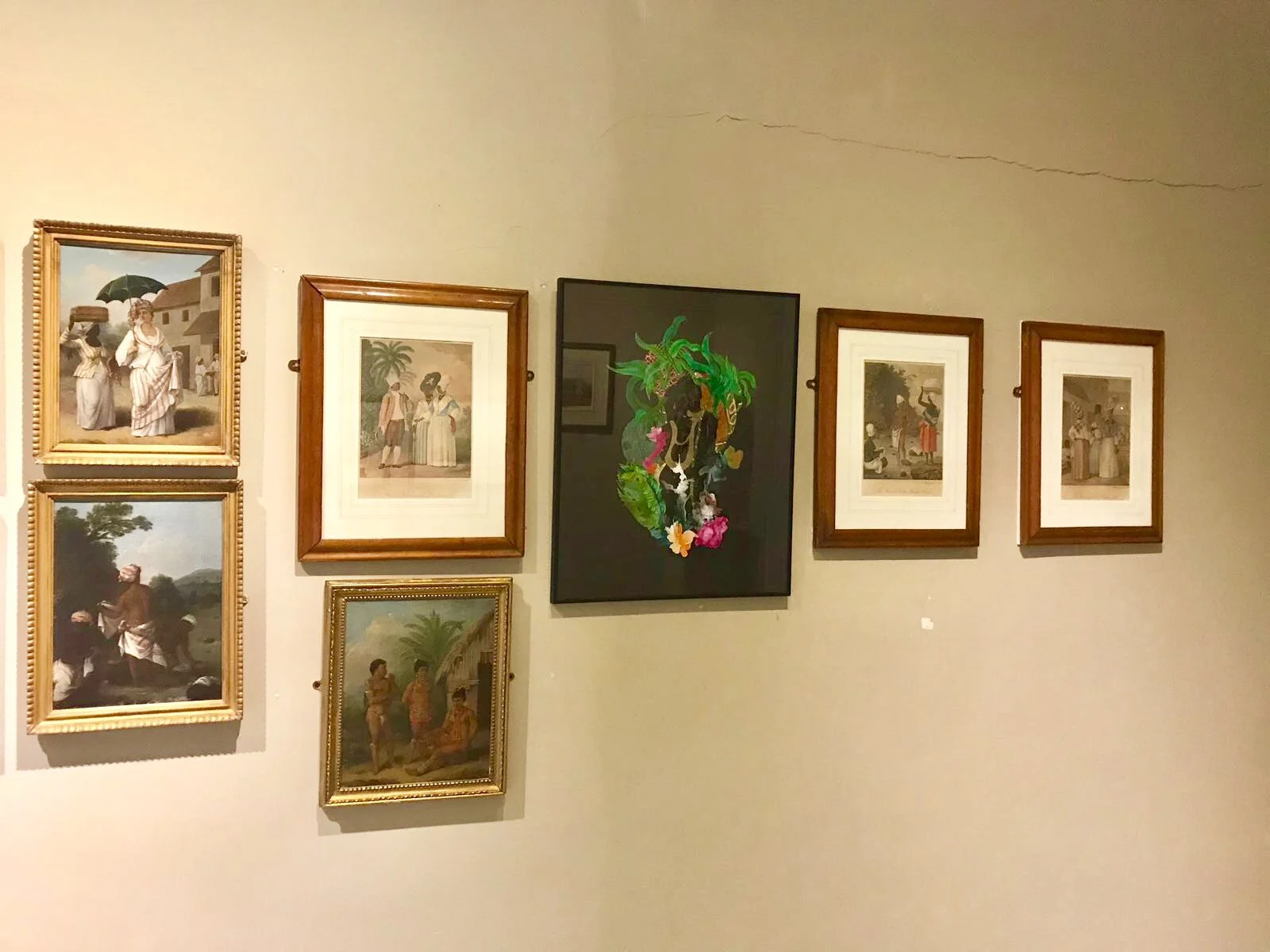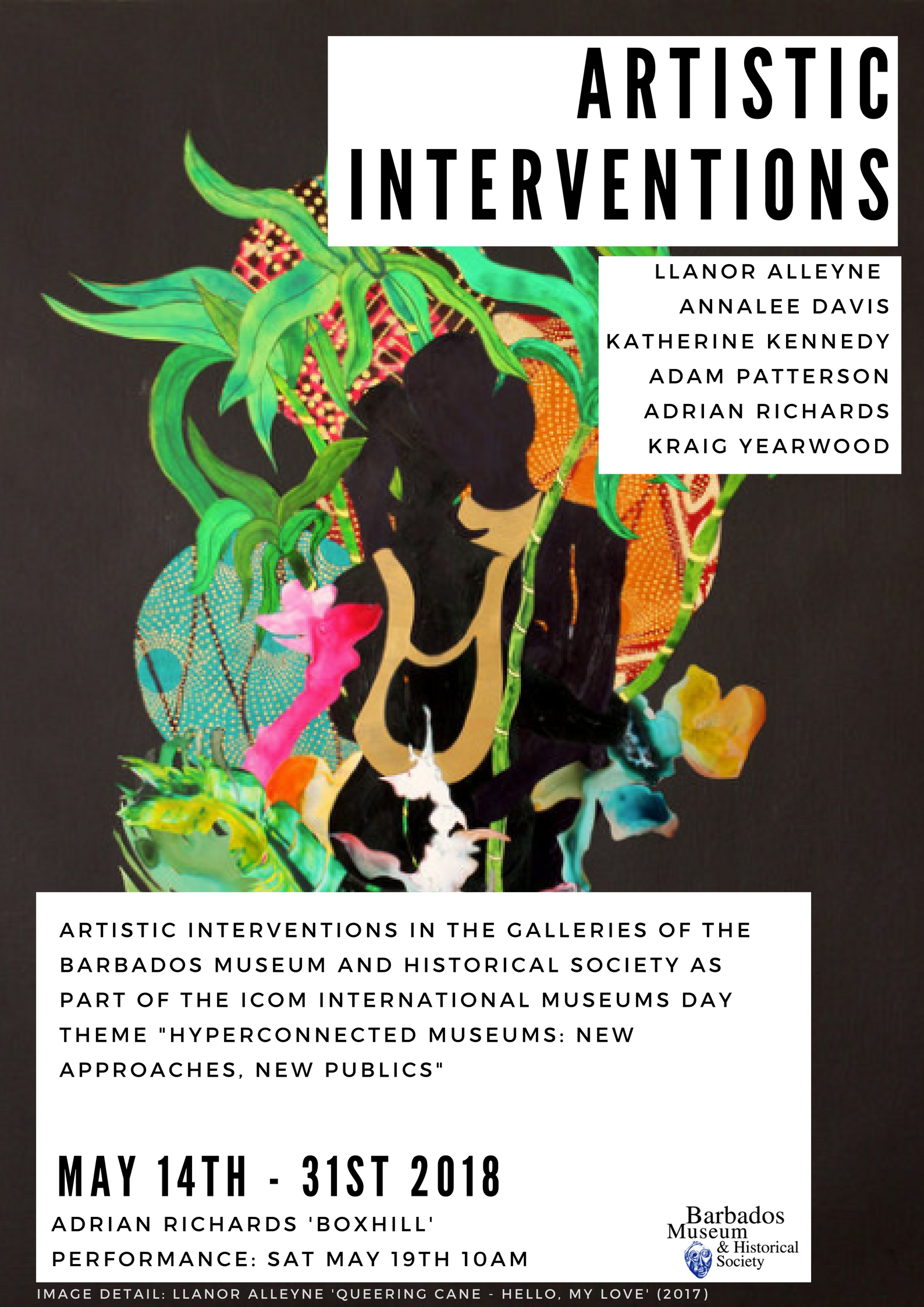“Queering Cane” Intervention at Barbados Museum & Historical Society During Museum Week
My collage “Hello, My Love” is currently on view at the Barbados Museum and Historical Society (BMHS) as part of International Museum Week 2018. Installed in the Cunard Gallery, the work is presented as an artist intervention alongside the museum’s colonial holdings. I was invited to participate in this initiative, which encourages local contemporary artists to directly engage with the museum’s historical collection through new work and temporary installations.
“Hello, My Love” is placed within a wall of original prints and lithographs by 18th-century Italian painter Agostino Brunias. His images depict idealized scenes of life in the colonial Caribbean, with a focus on genteel leisure, fashion, and domesticity. These prints—often seen as historical records—present a visual narrative that prioritizes elegance and control, subtly reinforcing the mythologies of colonial order and civility. The subjects in Brunias’s work, particularly Black and mixed-race figures, are rendered as ornamental, decorative, and non-threatening. They serve to soften the harsh realities of enslavement and colonial violence.
Absent from these works are the black bodies who toiled in the sugarcane fields and domestic settings that made such frivolity possible. In inserting "Hello, My Love" into this collection, I'm challenging the viewer to consider who is absent from Brunias' work as well as the life these missing people might have been exploring outside of serving the idyll/idle pursuits of the plantation class.
The inclusion of my collage within this context is a deliberate disruption. “Hello, My Love” is part of my Queering Cane series, created in response to Prizm Art Fair’s 2017 curatorial theme, Universal Belonging. The series began as a sketchbook exploration in the summer of 2017 and grew into a sustained investigation of what it means to live openly or quietly as a queer woman in the Caribbean. I use collage as a method of layering, obscuring, and reassembling the body in space. In this particular work, two silhouetted female figures hold one another inside a sugarcane field. They are framed by botanical elements—bright flowers, painted leaves—and emerge from a darkened background that mirrors the palette and formal composition of the Brunias works surrounding it.
Where Brunias offers soft light and muted tones, “Hello, My Love” uses sharp contrasts and saturated color. Where Brunias positions the female figure as passive or performative, my figures are active in their embrace. The piece is quiet, but not reserved. It is tender without apology. In placing this collage among historical images that erase or overwrite queer existence, I intend to insert another kind of presence—one that reflects lived intimacy and emotional truth.
The sugarcane field in this work functions both literally and symbolically. It is a site historically tied to labor, violence, and surveillance, but also one of concealment and coded freedom. In Queering Cane, I imagine the field as a private and tender space. It becomes a metaphor for both seclusion and safety, where queer women of color can exist outside of dominant scripts and find solace in one another. In Hello, My Love, the figures are not hiding but inhabiting that space on their own terms.
Earlier this year, Ladi’Sasha Jones, the 2018 Sophie Davis Curatorial Fellow for Gender and Racial Parity at the Norton Museum of Art, presented the Queering Cane series at the Black Portraitures Conference at Harvard University. In her talk, she described the works as offering a “fantastical effect to the realities of the queer woman’s body,” noting how the figures appear and disappear in layers of darkened space and color. She emphasized the movement throughout the works, the lack of static posturing, and the attention to bodily subjectivity.
That same energy animates “Hello, My Love”. The collage does not assert a single reading. Instead, it creates space for visibility without spectacle. It counters the curated gentility of Brunias with an offering of softness rooted in truth, not fantasy. The figures do not exist for the viewer’s gaze. They exist for each other.
Being invited to install this work within a national museum is deeply meaningful. It affirms the need to revisit and expand the narratives told through our cultural institutions. Museums hold immense power in shaping public memory. Interventions like this make space for new stories, new perspectives, and new possibilities. I see this moment not only as an opportunity to share my work but also to contribute to a broader dialogue about representation, history, and belonging in the Caribbean.
“Hello, My Love” will remain on view at the Barbados Museum through the end of May. I am thankful to Natalie McGuire and team at BMHS for the invitation and for making space for contemporary artists to engage critically with the past in ways that reflect the complexities of the present.


